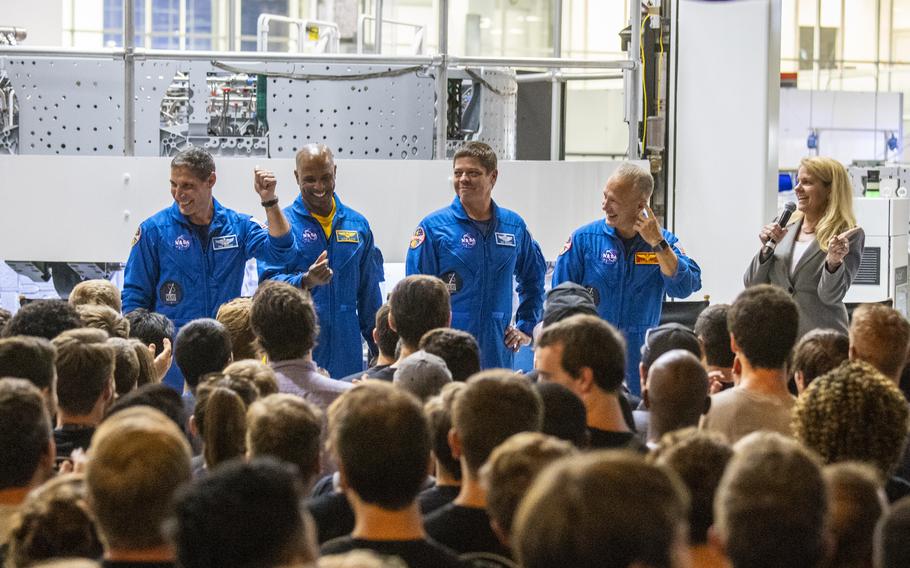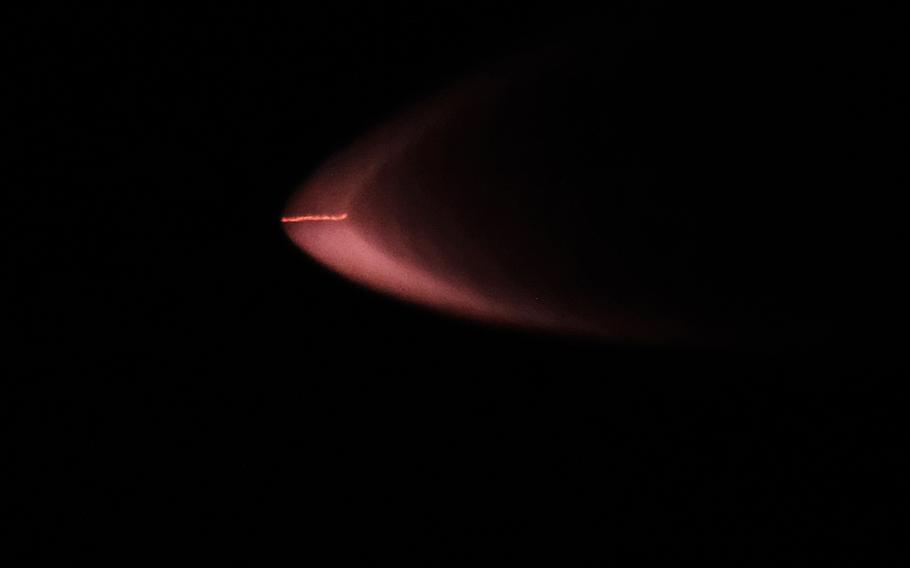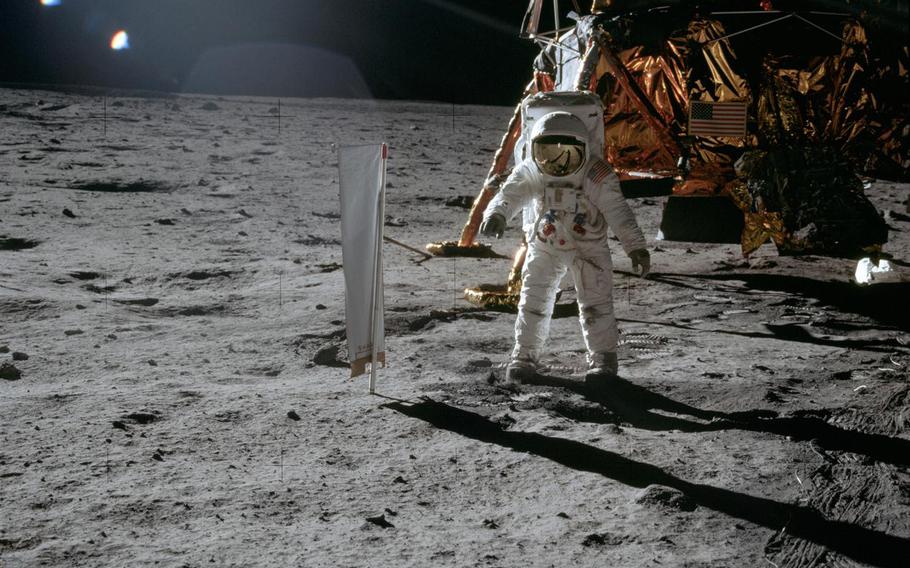
The first four NASA commercial crew astronauts for the SpaceX Crew Dragon with SpaceX CEO Gwynne Shotwell in 2018. (Jonathan Newton/The Washington Post)
Amused observers have long dismissed Elon Musk’s dream to colonize Mars as unserious science fiction. But in his pursuit of the Red Planet, Musk has managed to build a deadly serious business with vast military consequences.
Security experts say SpaceX has leapfrogged so far ahead in several critical technologies that it could deter major rivals like China from engaging in a war with the United States — or tip the balance if one breaks out. Others worry that it could provoke an untimely response.
Musk is in the first camp. In recent days he has remarked on X that his ambition to send crews to Mars as soon as 2028 would result in “alien-level technology that is crushingly better than competitors,” along with making an oblique reference to averting a war against China. That prospect may not be imminent, but it has become the focus of U.S. defense preparations as China rises.
Technological prowess is one reason SpaceX’s value has jumped to around $350 billion from $210 billion earlier this year, according to a recent Bloomberg report, pegging it as the world’s most valuable private company and most valuable defense contractor. Another likely reason: investors’ belief that Musk, the world’s wealthiest man, could find it easier to further enrich his business empire after aiding the campaign of President-elect Donald Trump.
Musk has said he founded SpaceX to get to Mars. His advanced satellite system Starlink — which he has said he set up partly to fund Mars expeditions — has proved to be a killer app on battlefields for steering next-generation drone swarms and coordinating troops. No other nation is anywhere close to matching the capability.
The company’s massive Starship, the most powerful rocket in history and the first reusable heavy-duty one, is likewise in a class of its own. Even as Musk has touted its potential to help humanity explore the cosmos, the Pentagon is eyeing its 165-ton carrying capacity for rapid transport of troops and gear to Asia in case of war.
Gen. B. Chance Saltzman, Space Force chief of space operations, traveled to Texas last month to watch the latest Starship launch and review the company’s operations. “The Department of the Air Force and the U.S. Space Force are monitoring Starship’s progress and look forward to potentially leveraging its capabilities in the future,” the Space Force said in a statement.
At an investor gathering last month, one of SpaceX’s early investors, Ron Baron, recalled SpaceX President Gwynne Shotwell once telling him that “one of the only things that’s preventing my grandchildren from speaking Mandarin is SpaceX.” Shotwell backpedaled the remark on camera — “No, that was very bold of me” — but confirmed she believed SpaceX is “very important” for U.S. national security.
SpaceX, Shotwell and Musk did not respond to requests for comment for this article.
Todd Harrison, a space policy analyst with the American Enterprise Institute, said it would probably take China 10 years to develop a rocket with carrying capacity like Starship’s, giving the U.S. military a window of exclusivity.
Gary Henry, former SpaceX senior director of national security space solutions, said he believed the next-generation military applications that can be built from Starlink and Starship will serve as deterrents that may prevent China from risking a war against the United States.
“I think no company or nation-state actor will be able to replicate or match Starship’s evolving performance capabilities in our lifetimes,” Henry said.
There has long been an intersection between space exploration and the military, dating back at least to World War II, when German engineer Wernher von Braun designed the V-2 rocket. And often new technology brings its own risks of sparking conflict. Earlier this year, Washington was roiled by the revelation that Russia had launched a “counterspace weapon” into orbit, which was partly a response to the U.S. satellite buildup. Security experts at the Lawrence Livermore National Laboratory have noted that U.S. dominance in low Earth orbit investment means China “has more latitude to start war in space” than the United States.
“These are old ideas, that the United States might be able to be so dominant in space that others might not even try to catch up or contest that dominance,” said Laura Grego, a senior scientist and research director at the Union of Concerned Scientists. “That kind of rhetoric caused a lot of distrust and … accelerated the space arms race that we are currently in.”
William Hartung, a senior research fellow at the Quincy Institute for Responsible Statecraft, who has been a critic of arms sales, called the predictions that SpaceX could help the U.S. deter or win a war against China “wishful thinking” that is “typical of the techno-optimism of the Silicon Valley defense sector.”
Such optimism exists outside the valley, too. Kari Bingen, a former deputy undersecretary of defense, likened today’s Mars dream to the 1960s race to the moon, which, despite criticism of Apollo’s extravagant costs, spurred technological advances like the miniaturization of computers.
“I think the same thing will happen here,” she said. “There will be technological and other benefits which we can’t fathom right now. But they will be amazing, and they will be game changers.”

A SpaceX Falcon 9 rocket streaks across the northeastern sky on Oct. 18, 2024, in Alexandria, Va. (Robert Miller/The Washington Post)
SpaceX has constructed Starlink, the world’s largest satellite network with about 6,400 satellites, in just five years, unlocking new capabilities for the U.S. government in encrypted communications, surveillance and next-generation drone warfare.
The recent revelations of the “Salt Typhoon” hacks, in which Chinese government hackers deeply compromised major U.S. phone and internet networks, has underscored Starlink’s value as a new airborne network circumventing traditional data “pipes.” The U.S. government has already shifted some communications to Starlink’s encrypted government service, Starshield. Although satellites are not immune to hacking either, Starlink’s equipment is manufactured in the United States, a rarity in the globalized telecommunications industry, providing less opportunity for a foreign hacker to intercept and tamper with gear.
Aside from its consumer internet service, Starlink is building out a next-generation network of surveillance satellites for government use, jostling with more established players like Maxar Technologies and Planet Labs. Industry experts say the company is on track to build the world’s first system able to monitor all spots on Earth continuously in near real-time, revolutionizing reconnaissance.
“When you look at what SpaceX has done to revolutionize cost,” said Robert O. Work, former deputy secretary of defense, “that is allowing us to get closer to real-time visibility across the globe using different sensors … You could have hardly dreamed of [it] a decade ago.”
Starlink has also emerged as a key tool on the modern battlefield, after Ukrainian soldiers pioneered tactics of steering swarms of bomb-rigged small drones into Russian targets, in a successful experiment partly funded by the Pentagon. William Gerstenmaier, SpaceX vice president of build and flight reliability, told the Senate Commerce Committee last year he believed the deployment of Starlink and Starshield were “crucial” to U.S. national security and foreign policy objectives abroad.
“Future wars are all about drones & hypersonic missiles,” Musk posted last week on X. “Fighter jets piloted by humans will be destroyed very quickly.”
U.S. defense officials are also eyeing Starlink’s potential uses in a theoretical conflict with China, according to former SpaceX executive Henry. Beijing has used missile installations and other tactics to prevent any unauthorized approach toward the country by plane or ship, a strategy dubbed “anti-access/area denial.” Satellites float freely at a higher altitude, Henry said, helping “America and its allies to project power necessary anywhere on the globe.”
Some ideas about these capabilities run counter to hard-won historical insights into the logistics of land-based warfare. Earlier this year, Maj. Brian E. Hamel wrote in Army Sustainment, a U.S. Army periodical, that satellites could even be potentially loaded with cargo needed by soldiers in a war against China, ranging from weapons to food to blood transfusions. The supplies could be released at the right point in orbit, he wrote, surmounting the “tyranny of distance” and challenging the conventional wisdom that the United States could never sustain an occupation of the Chinese mainland.
“The entire satellite could fall back to Earth or just eject the desired payload,” Hamel wrote.
Beijing has expressed displeasure at the U.S. satellite advances as it races to build a similar system. China Military Online, a media outlet run by the Chinese People’s Liberation Army, has fretted that Starshield may be able to conduct detailed reconnaissance of other nations and intercept foreign communications: “The entire Earth will be wrapped in a large web.”
Even the European Union, a U.S. ally, has worried that the United States alone commands such a powerful new tool, and is attempting its own version, called IRIS².
“Depending on a foreign private company is not exactly what European governments want,” said a European space industry executive, speaking on condition of anonymity to discuss a sensitive topic. “It would mean that at any time, this private company can decide to switch off communications.”
Even as Starlink’s satellites are revolutionizing communications and battlefield tactics, Shotwell recently predicted that the company’s giant rocket, Starship, will become the most valuable part of the business. NASA is investing $4 billion into Starship, with plans to use the rocket to return astronauts to the moon, a nearer-term goal than Mars.
In October, SpaceX successfully “caught” Starship’s first stage, Super Heavy, proving the massive system can be reusable. That suggests a dramatic drop in launch costs and could make Musk’s dream of a Mars colony a reality. “Big step towards making life multiplanetary was made today,” Musk celebrated on X.
It was a big step as well toward the Pentagon realizing its plan to build a rocket transport system that can shuttle troops and weapons to Asia within 90 minutes if a war breaks out with China. The Air Force awarded SpaceX a $102 million five-year contract in 2022 to develop such a system.
Bingen, the former Pentagon undersecretary, said it can take two to three weeks to resupply forces in the Western Pacific through traditional methods. This delay has figured into Washington’s concerns that Beijing could invade Taiwan, a geopolitical flash point, so quickly that the United States would not have time to come to its defense.
“How do you deliver supplies to a heavily denied environment? One way to do that is launch a rocket with the equipment and munitions you need, and have it land in a contested operating environment,” she said.
One dilemma there, however, is how to ensure a rocket cargo shipment flying downward is not mistaken for something else — say, a nuclear ballistic missile.
“We would not want to create confusion,” Bingen said. “These would be space launch vehicles, launched from very different locations from where we launch our nuclear missiles.”
Starship rockets could also potentially enable the U.S. military to head off a brewing war by rapidly assembling a show of force overhead, Henry said: “I can show a potential adversary … do you really want to go to the next level? Hopefully, they take their toys home, and we bring ours home.”
Peter Klupar, former director of engineering of the NASA Ames Research Center, said executives and officials are still getting their heads around how the Starship breakthrough will change technologies as we know them.
“People are behaving like it’s 1999, and the cost of lift is $100,000 a kilo,” he said. “We’re headed to a place where the cost of lift is going to be $100 a kilo.”
Musk has often gone big when discussing Mars. In a 2009 essay, he listed key events on Earth as including the emergence of multicellular creatures, the differentiation of plants and animals, and the advent of mammals. “On that scale,” he wrote, “the next important step is obvious: making life multiplanetary.”

Astronaut Buzz Aldrin on the lunar surface during the Apollo 11 mission on July 20, 1969. (Neil Armstrong/NASA)
People familiar with Musk say the Mars dream has been deeply woven into the DNA of SpaceX since its earliest days. Musk himself has called it the motivating force when in 2002, at age 30, he started Space Exploration Technologies Corp. in the aerospace hub of El Segundo, California. Fresh off a windfall from selling PayPal to eBay, Musk hoped to lower the stratospheric price of rockets to aide exploration of the Red Planet.
But whether by accident or design, SpaceX soon found its practical business to be spy satellites. The first customer Musk landed was the Pentagon, which took a chance on booking the Falcon 1’s maiden flight in part because Musk had promised to keep the rocket cost below the unheard-of low price of $6 million. The payload was a radically small and cheap satellite called TacSat-1, developed by the Navy and Air Force.
This first SpaceX rocket blew up in launch in 2006 and TacSat-1 never got off the ground. But defense officials helped Musk troubleshoot. More contracts followed with the Air Force and DARPA, the Pentagon’s experimental technologies agency.
This early exposure to the Pentagon’s cutting-edge satellite technology was valuable experience. In 2014, Musk began talking with a start-up called WorldVu, founded by a former Google executive, which had an audacious idea to build a next-generation satellite internet network in the air. The partnership with WorldVu fell apart, but Musk decided to build his own satellites.
While WorldVu and other rivals floundered, SpaceX’s Starlink satellites, first launched in 2019, succeeded. Today, Starlink controls more than half the satellites orbiting Earth, unlocking some of the futuristic capabilities that Pentagon engineers had envisioned two decades ago as they experimented with TacSat-1.
Until recently, Musk has discussed the military implications of SpaceX’s technologies in public only sparingly, focusing instead on his vision of interplanetary exploration.
“Starship will allow us to inhabit other worlds,” Musk tweeted in 2019. In July, he added: “Starship is the kind of thing that makes people from little kids to seniors excited about the future!”
In recent days, Musk has become bolder in his remarks, perhaps stung by criticism by celebrity astrophysicist Neil deGrasse Tyson over the feasibility of a Mars colony on Bill Maher’s “Overtime” show.
“For him to just say, ‘Let’s go to Mars because it’s the next thing to do,’ what does that venture capitalist meeting look like?” deGrasse Tyson had quipped. “’So Elon, what do you want to do?’ ‘I want to go to Mars.’ ‘How much will it cost?’ ‘A trillion dollars.’ ‘Is it safe?’ ‘No, people will probably die.’ ‘What’s the return on the investment?’ ‘Nothing.’ That’s a five-minute meeting, and it doesn’t happen.”
Musk took to X afterward, posting a meme based on Trump’s narrowly escaping an assassination attempt by turning his head. He was suggesting that SpaceX’s “Occupy Mars” goal could help produce a narrow miss of “World War 3.”
Aim high, beyond mere Earth orbit, he wrote. What assures payoff is “the absurdly ambitious nature of the goal.”
Christian Davenport and Nitasha Tiku contributed to this report.